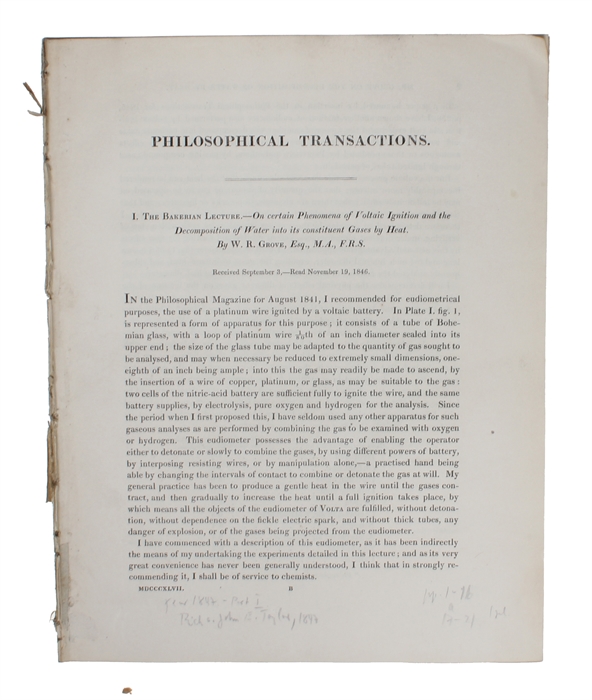GROVE, WILLIAM ROBERT. - THE FIRST FUELL CELL DESCRIBED BY THE "FATHER OF THE FUELL CELL"
The Bakerian Lecture. - On certain Phenomena of Voltaic Ignition and the Decomposition of Water into its constituent Gases by Heat. Received September 3, - Read November 19, 1846. (+) Supplementary Paper on certain Phenomena of Voltaic Ignition, and the Decomposition of Water into its Constituent Gases by Heat. Received November 26, - Read November 26, 1846.
(London, Richard and John E. Taylor, 1847). 4to. No wrappers as extracted from "Philosophical Transactions" 1847 - Part I. Pp. 1-16 a. pp. 17-21 and 1 lithographed plate
First appearance of an importent paper in which Grove describes and depicts his invention - from 1839 - of the first FUEL CELL, which he named "The Gas Voltaic Battery", and where he applied his anticipation of the principle of "Conservation of Energy" to the decomposition of water. and to the ignition of the released gases.
In 1846, Grove published "On The Correlation of Physical Forces" in which he anticipated the general theory of the conservation of energy that was more famously put forward in Hermann von Helmholtz' Über die Erhaltung der Kraft (On the Conservation of Force) published the following year.His 1846 Bakerian lecture relied heavily on his theory.(The paper offered).
During the early 1960s, General Electric produced the fuel-cell-based electrical power system for NASA's Gemini and Apollo space capsules. General Electric used the principles found in the "Bacon Cell" as the basis of its design. Today, the Space Shuttle's electricity is provided by fuel cells, and the same fuel cells provide drinking water for the crew.
NASA decided that using nuclear reactors was too high a risk, and using batteries or solar power was too bulky to use in space vehicles. NASA has funded more than 200 research contracts exploring fuel-cell technology, bringing the technology to a level now viable for the private sector
Order-nr.: 46461

